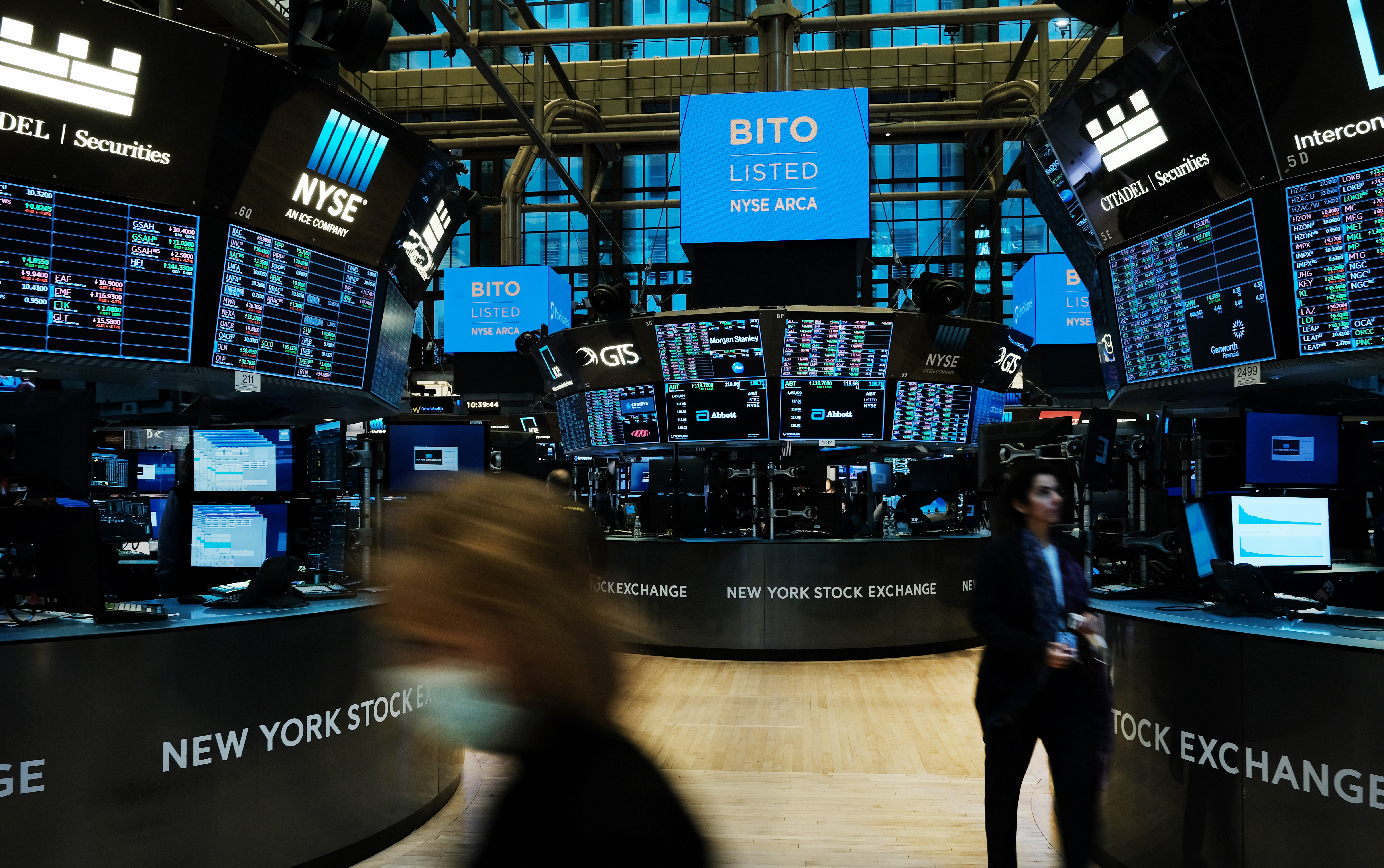The new Bitcoin ETF, explained

ProShares Bitcoin Strategy Fund made a historic debut on Monday as the first “bitcoin-linked” ETF on the New York Stock Exchange. [Spencer Platt via Getty Images]
There’s never a dull moment on the blockchain. Here’s what you need to know this week:
A Bitcoin futures ETF has arrived. We’re breaking down everything you need to know.
Hot NFT projects are cooling as crypto rallies. Why aren’t the two markets moving in sync right now?
The most intriguing quotes of the week. Hot takes and compelling microstories from the cryptoverse.
Bit to the Future
After eight years, a U.S. Bitcoin ETF is finally here. But what is it exactly?
In recent weeks, as Bitcoin chugged back above $60,000, one category of crypto headline was almost impossible to miss: the imminent arrival of the first-ever “Bitcoin futures ETF.” Yesterday, ProShares Bitcoin Strategy fund (BITO) listed on the New York Stock Exchange after a 75-day review by the SEC. The milestone arrived eight years after the Winklevoss twins applied for the first Bitcoin ETF — back when a bitcoin cost about $90. So why now? And just what the heck is a Bitcoin futures ETF? Let’s dive in.
ETFs, or exchange-traded funds, — a $6.7 trillion industry — are popular with everyone from retirement-savings investors to giant Wall Street funds. ETFs are similar to mutual funds — they provide investors exposure to an asset (like gold) or a basket of assets (like tech stocks). They also tend to have low fees and, as the name implies, are traded on major stock exchanges, meaning they can be bought or sold via any major brokerage.
Futures ETFs are distinct from spot-market ETFs, which invest directly in an asset. Proshares BITO invests in BTC futures, which are a bundle of contracts to buy BTC at a future date for a specific price. BTC futures tend to be correlated with bitcoin prices (meaning they roughly move up and down together), but they aren’t exact mirrors of each other.
SEC Chair Gary Gensler acknowledged futures-based BTC ETFs in remarks this year, citing the “significant investor protections” provided by the Investment Act of 1940 for futures-based trading (one legal analyst disputed this rationale). However, spot-based BTC ETFs and other parts of the crypto market still lack regulatory clarity (read our policy proposal).
Several additional futures-based BTC ETFs are expected to launch by the end of October, including Valkyrie’s BTFD fund (a sly joke?). In total, about 40 crypto ETF applications — including Ethereum funds and more — have been submitted to the SEC, which has a history of extending deadlines for rulings on digital asset ETFs.
More than 24 million shares of BITO (worth nearly $1 billion) traded on Tuesday, as the fund became the second-most heavily traded fund on record — “a watershed moment for the crypto industry,” according to Bloomberg. Retail traders were hungry for shares, with BITO becoming the most-bought asset on Fidelity’s platform in the first few hours of trading. Bitcoin prices rose as well — breaking the $64,000 mark for the first time since April.
Why it matters… Much of the excitement around BTC ETFs comes from investors’ belief that such funds could broadly appeal to traders who aren’t yet comfortable with the idea of buying crypto directly. (And indeed, existing crypto ETFs in Canada and Latin America have been big hits.) While these first futures-based BTC ETFs might hold more appeal for advanced traders looking to diversify portfolios with indirect exposure to bitcoin, some analysts predict that they’ll pave the way for ETFs that hold crypto directly. According to Douglas Yones, the head of exchange-traded products at the NYSE: “This is an exciting step but not the last.”
NFT Update
Crypto is booming, so why are some major NFT projects struggling?
Bitcoin broke $50,000 for the first time in February 2021, around the time Christie’s auctioned off a Beeple NFT for $69.3 million. So you’d think that crypto prices and NFT sales would be pretty tightly correlated. But that hasn’t seemed to be the case. Take August, for example: at the time, crypto prices remained depressed, but NFT market OpenSea posted a record $3.4 billion in trading volume. This week, however, as Bitcoin came close to spring’s all-time highs, many major NFT projects lost steam — and OpenSea logged a roughly 30% drop in daily trading volume over the last week. Time for a closer look.
Just weeks after notching their first $1 million sales, Ethereum collectible projects Cool Cats and CrypToadz saw their floor prices fall sharply. Meanwhile, Degenerate Apes, the avatars that sent Solana to all-time highs in August, posted their lowest average prices since launch on Monday.
After a blockbuster $60 million launch last week, the Gundam-inspired Mekas generative NFT project shed value (from a floor price above 7 ETH to less than 2 ETH on October 15) after some major NFT collectors claimed that developers had rigged the raffle system used for the launch. On the project’s Discord, Mekas’ developers insisted that “everything was distributed clearly, fairly, and randomly.”
Even with this week’s declines, October NFT sales still seem poised to match August’s highs. NFTs that maintained momentum include a new drop from NBA Top Shot, featuring Shaquille O’Neal and Dwayne Wade. The retro pack seemed to renew interest in the collectible marketplace. CryptoPunks also held steady, and (in case you were wondering) the lowest price for a digital pet rock is still above $1 million.
Why it matters… When NFTs first took off in early 2021, the thesis was that crypto whales, flush from the bull run, were looking to park some of their holdings — and that NFT sales would cool alongside the broader market. But when crypto slumped this summer, record interest in NFTs led creators to mint collectibles, in-game creatures, and tens of thousands of unique avatars. It may be that the vast proliferation of projects makes any single project less buzzworthy, which might be good for collectors who just love the art (as opposed to speculators looking to make a bundle of ETH). But NFTs change fast — an exciting new project, a viral artwork, or a rare zombie Punk can move the market in unexpected ways.
Takes
Big Short investor goes long on (some) crypto, Morgan Stanley CEO says crypto is here to stay
Wall Street bets… During Morgan Stanley’s Q3 earnings call, CEO James Gorman addressed crypto’s longevity. “I don’t think crypto is a fad,” he said. “These things aren’t going away, and the blockchain technology supporting it is obviously very real and powerful.”
Bitcoin faithful... Addressing Congress about the U.S. debt ceiling showdown, Wyoming Senator Cynthia Lummis said: "Time and again…presidents of both parties have run up the debt irresponsibly with no plan to address it. So thank God for Bitcoin...that transcends the irresponsibility of governments, including our own."
Burry sorry... Big Short investor Michael Burry, who has issued dire warnings about cryptocurrencies from BTC to SHIB, clarified his position: "I've not been shorting cryptocurrencies at all," he said. "I have not been involved in them except for a dabble — actually on the long side in a couple that I see as 'better' cryptocurrencies."
Shark bank… Shark Tank investor Kevin O’Leary said he sees “trillions of dollars” moving into crypto: “For the first time ever, my crypto exposure is greater than gold.” O'Leary wasn’t the only Shark Tank star to weigh in: in a series of tweets, Mark Cuban laid out his case for BTC as “the best store of value on the market” with “ZERO competition.”
TOKEN TRIVIA
What is an example of hot storage?
A
A piece of paper with your private keys, kept in a safety deposit box
B
A crypto wallet connected to the internet
C
A wool-lined crate
D
Any crypto account protected by two-step authentication
Find the answer below.
Trivia Answer
B
A crypto wallet connected to the internet











